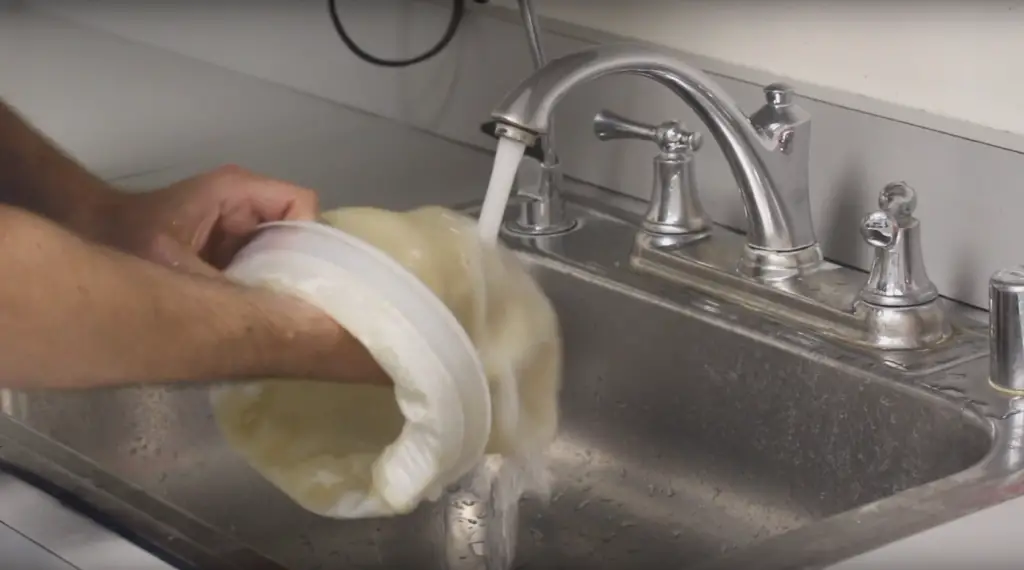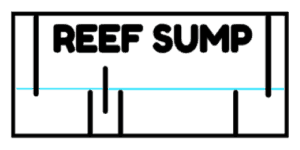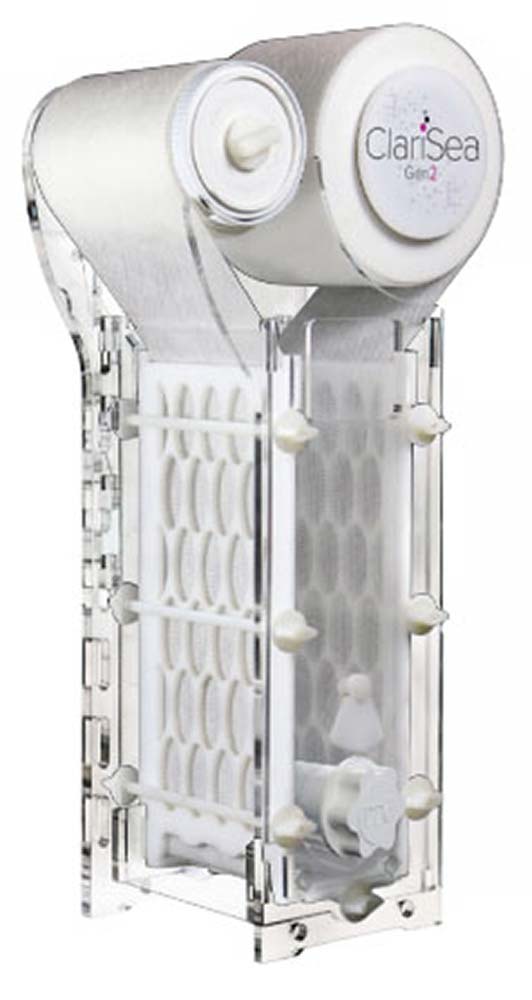
Back in the day, my first reef tank was a non-drilled 55-gallon reef tank where I used a canister filter. After graduating to a big boy reef tank, I’ve always used a sump on my reef tanks, and short of an all-in-one tank, I probably wouldn’t set up another tank without a sump if it can be avoided. One of the features that most sumps utilize are filter socks. Filter socks are part of a sumps mechanical filtration system. Filter socks trap large particulate matter in the reef tank system and allow you to manually remove waste from your system before it can further break down into harmful nitrate and eventually ammonia. Read on to learn everything about using filter socks on reef aquariums.
What are filter socks?
Filter socks are large tube sock-looking filter devices that are commonly found in reef tank sumps. Filter socks are usually placed on the receiving end of the reef tank’s overflow pipe. In some sumps, the overflow pipe drains into an overflow chamber then overflows into a filter sock chamber where the filter socks receive the water and filter it before going through the sump and returning to the tank. Filter socks work by trapping particulate matter within the sock as the water passes through it.
What do filter socks do?
Filter socks are a great option for mechanical filtration on a reef tank. Once filter socks are dirty and full of particulate matter they are manually removed from the sump and swapped out with clean socks. Filter socks do a good job of keeping reef tank water clear and can be an effective part of your nutrient export process when properly maintained. Because filter socks require you to continuously change them out they can be very good for a tank or somewhat detrimental, if you do not clean your filter sock regularly. As Filter socks trap large pieces of waste and uneaten food, when you remove the sock you are directly removing the waste before it can break down into nitrates and ammonia which could harm your tank. If the sock is left too long in the sump the breakdown process continues and the waste can break down into nitrates and eventually ammonia which is bad for tank inhabitants. If you have a protein skimmer it should pick up the smaller particles that make it through the socks, but better to remove before it gets to that state.
What type of material are filter socks made of?
Filter socks are primarily made up of two types of felt type material polyester and polypropylene. I prefer to use polyester filter socks for a couple of main reasons. First, I like to machine wash my filter socks and find that after a few washes polypropylene filter socks will start to bunch up like a sweater, leading to less efficient filtering and lower lifetime usage. I’ve also found that polypropylene filter socks can sometimes cause my skimmer to create so much foam that it overflows. This is fixable by thoroughly rinsing polypropylene socks before using and turning off the skimmer for a couple of hours after adding brand new polypropylene socks.
Another type of filter sock is mesh filter socks. Mesh filter socks are typically made of a nylon monofilament type mesh. These filter socks are used to trap very large particulate matter, like uneaten fish food, and also work great to filter media like carbon. Mesh filter socks are very easy to clean and don’t get clogged easily. These socks are usually used in special cases with media or if you plan to change them out frequently.
Filter socks also have two primary tops to them. Most filter socks have a hard ring at the top of the sock to allow you to place them into your sump or sock holder to create a tight seal to maximize the amount of water going into the sock before it goes through the sump and returns to the tank. The other style of socks, mostly found with mesh socks is the use of a drawstring at the top of the sock. The drawstring allows you to cinch a sock around an overflow pipe.
What sizes of filter socks are there?
When considering the size of filter socks there are three different size components to consider: the length of the sock, the diameter of the ring, and the micron size.
Length of the sock: There are many different lengths of filter socks on the market. Generally, a short filter sock would be about 8”, a medium length sock would be about 11”, and a long sock would be about 16”. To choose the right length of the sock, I like to go as big as possible with where you are going to place the sock so that you have at least about an inch gap from the bottom of the sump to the bottom of the filter sock. The larger the sock, the more surface area you have to trap debris.
Ring diameter: This is an important measurement. Matching the right ring diameter of the sock and the sock holder will ensure a tight fit so that no water bypasses the sock before moving through the sump and back into the tank. Most sumps and sock holders will tell what ring diameter of the sock to use.
Micron size: Micron size is a size measurement of the pores of the sock. The pore size will determine what size particulate matter the sock is capable of trapping. A smaller micron sock has smaller pores meaning it will trap smaller particles. The two most common filter sock micron sizes are 100 micron and 200 micron. A 100-micron sock will trap debris 100 microns and larger while a 200 micron is for debris 200 microns and larger. The advantage of a 100-micron sock is that you will trap smaller debris before it moves through the sump. The advantage of a 200-micron sock is that it will take longer to get clogged requiring less maintenance. If you run a protein skimmer a 200-micron sock is your best bet which balances effectiveness and maintenance needs well. 100-micron socks can be used every once in a while to polish water even more than a 200 can, but in general, it isn’t necessary with a fully functional sump.

As a side note, some sumps have their own sized filter socks such as Red Sea tanks. Red Sea tanks can only fit their branded filter socks.
What size of filter socks are the best?
The best size of filter sock to use is one that is long enough to have a gap of at least 1” from the bottom of your sump to the bottom of your filters sock, a matching ring diameter to provide a tight seal on the filter sock holder, and sock that is 200 microns.
How can you tell when to change filter socks?
Filter socks will tell you when they need to be changed. When it’s time to change filter socks, they will become clogged and unable to filter all of the water being sent to them. They will overflow out of the top of the socks and spill into the sump without being filtered. You can also visually see a dirty filter sock. Most filter socks are white and will turn dark shades of green when they are full of waste.
How often should you change your filter socks?

The frequency of changing your filter socks will depend on your tank size, bioload, and how much you are feeding your fish. A best practice is to change your filter socks before they are very dirty. The more frequently you change and clean your filter socks, the more waste you are removing from your system before it can break down into nitrates.
In my reef tanks, I like to do maintenance two times a week on Tuesdays and Saturdays. On Tuesdays, I scrap the glass and change my socks. On Saturdays I do a water change, scrap the glass, and change the socks. Daily I inspect my systems and if I find visually dirty socks or overflowing then I change them right away. There’s no harm in swapping out socks early.
What is the best way to clean filter socks?
The best way that I’ve found to clean filter socks is to use clothes washing machine. To change my socks I remove them from my sumps and place them into a clean 5-gallon bucket. Then I turn the socks inside out inspecting the contents. It’s always a good practice to see what you find in socks. Sometimes you may find a stray fish, hermit, or snail that you can rescue before washing. I like to rinse my socks in the sink before washing so that any algae or fish turds don’t get into my washing machine. I was on a regular cycle with hot water only. You can use bleach, but I don’t find the need to use bleach when washing. The spin cycle is usually good enough to dry socks, I never use the dryer to dry my filter socks.


Other methods for washing filter socks include using a pressure washer outside on a low setting and handwashing in your sink.
When should you throw away a filter sock?
Filter socks should be tossed and thrown away if they start ripping at the seams or on stitching and when holes start to develop throughout the sock. A good work filter sock will start to tear and you will be able to see through it when it is time to replace it. A high-quality filter sock will last a good 6-12 months if you have many going through a rotation. On my 210-gallon reef tank, I keep 12 socks on hand and my Trigger Emerald 39 sump uses 3 socks at a time. I usually replace in the 6-12 month time frame.
How to mount filter socks
In most modern pre-built sumps they will almost certainly include a filter sock holder or section for the inclusion of filter socks. In this case, you simply buy the right size sock and install them in the sock holders. If you are using a DIY sump or one that does not have a filter sock holder or section, there are many products on the market nowadays that work well to retrofit a sock into your sump. Typically these are filter sock rings attached to a mount that secures to the wall of your sump. Simply mount one of the rings around your overflow drainpipe and attach your sock to the ring. Here are a few filter sock retrofit options:

4″ Pre Sump Filter Sock Holder/Mount
Simple acrylic sump filter sock mount.
What can you use instead of a filter sock?
One of the newer products in the hobby in recent years is the rollermat filter. This can be described as a roll of filter material that looks like a roll of toilet paper. Water from the tank passes over a section of the paper roll and as it traps debris on the roll, it automatically replaces the dirty section with a clean section. This allows you simply change the roll when it has completely been used up. Most of these rollermat systems are built to be dropped into existing sumps and may or may not work in your current system. Many sumps are now being built to accommodate a rollermat out of the box. Cost is the primary drawback to rollermats currently.
Other options include using filter media instead of socks or not using socks altogether. In my opinion filter socks work great and the frequency of changing the socks is not an issue for me and keeps me more connected to my tanks.
Where to buy filter socks?
I buy my filter socks from Amazon. Here is the type of filter sock I use with great success.
Aquatic Experts 200 Micron Filter Stocks
Pre-molded with internal plastic handles for easy servicing, micron socks are truly the best upgrade to your filter/sump for polishing water. Most sumps will readily accept the Aquatic Experts felt filter sock.




